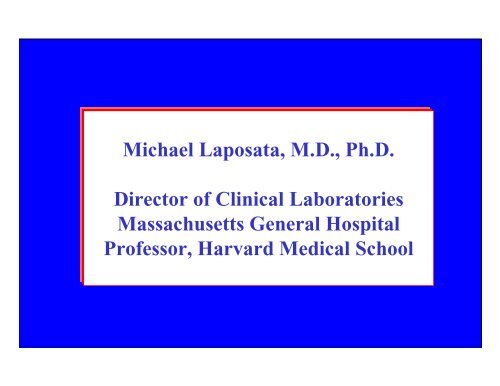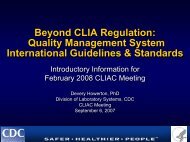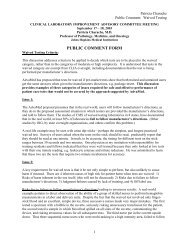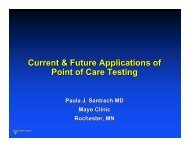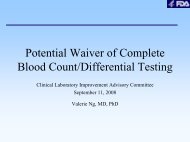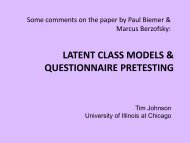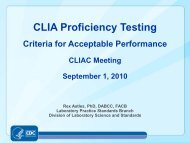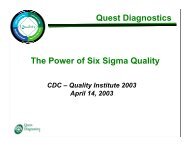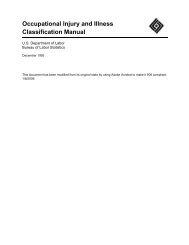Michael Laposata, M.D., Ph.D. Director of Clinical Laboratories ...
Michael Laposata, M.D., Ph.D. Director of Clinical Laboratories ...
Michael Laposata, M.D., Ph.D. Director of Clinical Laboratories ...
Create successful ePaper yourself
Turn your PDF publications into a flip-book with our unique Google optimized e-Paper software.
<strong>Michael</strong> <strong>Laposata</strong>, M.D., <strong>Ph</strong>.D.<strong>Director</strong> <strong>of</strong> <strong>Clinical</strong> <strong>Laboratories</strong>Massachusetts General HospitalPr<strong>of</strong>essor, Harvard Medical School
Has the right testbeen ordered?Error between resultreceipt and action?ActionOrderingInterpretationCollectionReportingIdentificationAnalysisTransportationPreparationThe nine steps in the performance <strong>of</strong> any laboratorytest. The brain-to-brain turnaround time loop.Lundberg, 1981
What points in the process have thehighest incidence <strong>of</strong> errors ?Test selection by clinicians ?Interpretation <strong>of</strong> test resultsby clinicians?YES
Medical Errors: Likelihood for recognitionError•Administration <strong>of</strong>the incorrect drugor incorrect dose <strong>of</strong> drug•Technical error in asurgical procedure•Incorrect or insufficientlaboratory tests ordered•Misinterpretation <strong>of</strong> laboratory testresult, leading to misdiagnosis orinappropriate/inadequate treatmentLikelihoodModerate - HighHighLowLow
Test related errors outside MGH – which laterpresented at MGH and were detected at that timeYoung father accused <strong>of</strong> shaking his baby –child had significant bleeding disordermissed by ordering clinician who mistakenlyinterpreted test results forvon Willebrands disease.Outcome-Father imprisoned, parents divorced
Test related errors outside MGH – which laterpresented at MGH and were detected at that time33 year old pregnant woman told she hassevere risk for thrombosis because <strong>of</strong> lowProtein S value. Clinician did not knowProtein S is lowered in most pregnancieswithout risk <strong>of</strong> thrombosis.Outcome - Woman terminates a normalpregnancy she desperately wanted to keep.
Increased cost <strong>of</strong>care from lab tests& technologist laborDelay in time to diagnosiswith increased length <strong>of</strong>stay for inpatientsINCORRECT LABORATORY TESTS ORDEREDOR MISINTERPRETATION OF TEST RESULTS<strong>Ph</strong>ysician time lostin assessment <strong>of</strong>incorrect tests<strong>Clinical</strong> consequences andemotional distress fromunnecessary procedureor misdiagnosis
Changes in the Scope <strong>of</strong> Care Providedby Primary Care <strong>Ph</strong>ysicians<strong>Ph</strong>ysicians’ Assessments <strong>of</strong> the Appropriateness<strong>of</strong> Primary Care <strong>Ph</strong>ysicians’ Scope <strong>of</strong> CareScope <strong>of</strong> CarePrimaryCare<strong>Ph</strong>ysicians(N=7015)N. Engl. J. Med, Dec. 23, 1999Specialists(N=5092)Greater than itshould be24 + 0.8 38 + 0.8
STRATEGY #1Use reflex testing asmuch as possible toincrease appropriateness<strong>of</strong> test selection
1 Check in Box for Prolonged PTT PanelInitiates Use <strong>of</strong> This Test Selection AlgorithmProlonged PTT EvaluationDegrade heparin in sample and repeat PTT -if the PTT normalizes, heparin is the causePTT mixing study (1:1 mix <strong>of</strong>patient:normal plasma)PTT NormalizesPTT remains prolongedFactor deficiencymeasurefactors VIII, IX,XI, and XIIInhibitor, most commonly Lupus anticoagulant;may be a Factor VIII inhibitorif PTT mixing study first normalizes andthen becomes prolongedPerform tests for specific inhibitorssuggested by results <strong>of</strong> PTT mixing study
MGH experience with detectable errors in testselection by cliniciansTest selection errors by commerciallaboratory clients for hypercoagulablestatesThe clients were not given the opportunityfor reflex testing and forced to selectindividual tests from a large test menu
Percentage <strong>of</strong> Total Requistions4035302520151050Interpretations Reduce Test Ordering ErrorsFirst 3 monthsAfter 2 years <strong>of</strong>interpretationsNone One Two Three Four None One Two Three FourNumber <strong>of</strong> Errors Per Requistion
STRATEGY #2Provide patient-specific narrativeinterpretations <strong>of</strong> the test results,as done in Anatomic Pathology andRadiology, for complex evaluationsin many areas <strong>of</strong> Laboratory Medicine,obtaining clinical information whennecessary to enhance the speed andaccuracy <strong>of</strong> the interpretation.
THE LIST OF LABORATORY MEDICINEINTERPRETIVE ROUNDS AT THE MGHCurrently active-CoagulationAutoimmune diseaseHemoglobinopathy/AnemiaTransfusion reactions &Complex transfusion casesSerum protein analysisTo be activated-HepatitisTo be reactivated-ToxicologyNeeded but not created-Endocrinology
1996 Survey <strong>of</strong> MGH physician experience withnarrative interpretations <strong>of</strong> complex laboratoryevaluations in coagulationOrdering physicians sent a narrativeinterpretation <strong>of</strong> one their own casesClinicians asked to respond to severalquestions about the interpretation46 0f 100 surveys returned
THIS INTERPRETATION SHORTENEDTHE TIME TO A DIAGNOSIS ?6.5%34.8%58.7%YESNONO ANSWER
THIS INTERPRETATION PROBABLYREDUCED THE NUMBER OFLABORATORY TESTS REQUIRED TOMAKE A DIAGNOSIS ?26.1%2.2%71.7%YESNONO ANSWER
THIS INTERPRETATION HELPEDAVOID A MISDIAGNOSIS ?21.7%6.5%71.7%YESNONO ANSWER
DO YOU FIND THESEINTERPRETATIONS USEFULOR INFORMATIVE ?2.2%97.8%YESNO
2000 Survey <strong>of</strong> MGH physician experience withnarrative interpretations <strong>of</strong> complex laboratoryevaluations in coagulationOrdering physicians electronically sent anarrative interpretation <strong>of</strong> one their own casesClinicians asked to respond electronicallyto several questions about the interpretation100 <strong>of</strong> 100 surveys returned
Interpretation Impact - <strong>Ph</strong>ysician OutcomesPercentage <strong>of</strong> Total Responses9080706050403020100Saved <strong>Ph</strong>ysicianTimeImpacted DifferentialDiagnosisReduced Time toDiagnosis
Interpretation ImpactMedical Utilization40Percentage <strong>of</strong> Total Responses3530252015105Reduced LabTestingReduced MedicalProceduresReducedAdmissionsReducedMedicationsReduced BloodProduct UsageReducedSpecialistConsultationIncreasedSpecialistConsultation0
Interpretation Impact - FinancialSavings per Year (Dollars)140000120000100000800006000040000200000OutpatientMedicalProceduresInpatient MedicalProceduresLab TestUtilizationBlood ProductUsage
CONSERVATIVE ESTIMATE OF SAVINGSFROM IMPLEMENTATION OF NARRATIVE REPORTYEAR# BILLED UNITS-ALL SERVICES# COAGINTERPS# COAG/ALL INTERPS199914189418028.2200016202508731.4200117710542330.6200220557516825.1
CONSERVATIVE ESTIMATE OF SAVINGSFROM IMPLEMENTATION OF NARRATIVE REPORTAverage % <strong>of</strong> billed units as coagulation interpretations:28.8 %Total quantifiable annual savings from coagulation service :$ 217,000Total quantifiable savings for all services by % <strong>of</strong> billable units :$ 753,472
REQUEST FOR IMPLEMENTATION OFPROGRAM TO REDUCE LABORATORY ERRORSFrom General Clinicians1. Make the service availableand easy to use2. Request for subspecialist cooperation3. Quality and efficiency are driving forces
BARRIERS TO IMPLEMENTATION OFPROGRAM TO REDUCE LABORATORY ERRORSFrom Pathologists1. Lack <strong>of</strong> expertise by pathologists2. Fear <strong>of</strong> subspecialist response3. No expectation <strong>of</strong> payment4. Complacency with canned comments5. Lack <strong>of</strong> interest by academic pathologists
BARRIERS TO IMPLEMENTATION OFPROGRAM TO REDUCE LABORATORY ERRORSFrom Administrators1. Cost <strong>of</strong> lab errors is not great2. Lack <strong>of</strong> trust regarding request tosupport a new service in pathology3. No expectation <strong>of</strong> payment or costsavings <strong>of</strong> magnitude
STRATEGY #3Create a national group <strong>of</strong>experts in the areas <strong>of</strong> LaboratoryMedicine to provide the narrativeinterpretations (A “Supreme Court”)and link the experts to the physiciansrequesting advice and theirpathologists through a web-basedInternet service
VIEWS OF PRACTICING PHYSICIANSAND THE PUBLIC ON MEDICAL ERRORS• Parallel national surveys <strong>of</strong> 831 practicingphysicians, who responded to mailedquestionnaires, and 1207 members <strong>of</strong> thepublic, who were interviewed by telephoneafter selection with the use <strong>of</strong> random-digitdialing.• Respondents asked about the causes <strong>of</strong> andsolutions to the problem <strong>of</strong> preventablemedical errors.N Engl J Med 2002; 347:1933-40
PERCEIVED CAUSES OFPREVENTABLE MEDICAL ERRORS<strong>Ph</strong>ysicians(N=831)Public(N=1207)P ValuepercentUnderstaffing <strong>of</strong> nurses in hospitals5365
Influence <strong>of</strong> HMOs and othermanaged-care plans ontreatment decisionsComplexity <strong>of</strong> medical carePERCEIVED CAUSES OFPREVENTABLE MEDICAL ERRORS<strong>Ph</strong>ysicians Public(N=831) (N=1207)percentInsufficient time spent by doctorswith patientsLack <strong>of</strong> computerized medicalrecords39383713N Engl J Med 2002; 347:193348627235P Value
POSSIBLE SOLUTIONS TO THE MEDICAL ERRORSRequiring hospitals to developsystems for preventing medicalerrorsIncreasing the number <strong>of</strong> nursesin hospitalsGiving physicians more time tospend with patients<strong>Ph</strong>ysicians(N=831)555146percentPublic(N=1207)746978P Value
POSSIBLE SOLUTIONS TO THE MEDICAL ERRORS<strong>Ph</strong>ysicians(N=831)percentPublic(N=1207)P ValueLimiting certain high-riskprocedures to hospitals thatperform many proceduresImproving the training <strong>of</strong> healthpr<strong>of</strong>essionals40364573


